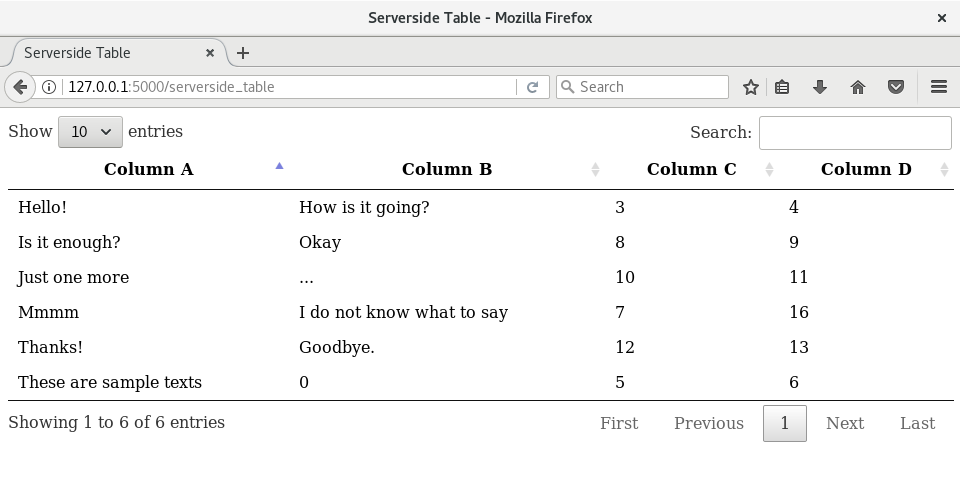The main purpose of this repository is to create a reusable class (ServerSideTable) that manages the server-side data processing for DataTables in Flask back-ends.
Although it contains all the boilerplate to make the example runnable, the reusable part is the folder called serverside and it is composed by two files:
- serverside_table.py:
- It contains the ServerSideTable class. It is NOT necessary to touch it.
- table_schemas.py:
- It defines the schemas of the server-side tables we want to display.
- Each schema is a list of Python dictionaries that represents each of the table's columns. The columns can be configured with the following fields:
- data_name: Name of the field in the data source.
- column_name: Name of the column in the table.
- default: Value that will be displayed in case there's no data for the previous data_name.
- order: Order of the column in the table.
- searchable: Whether the column will be taken into account while searching a value.
In order to run this example, you just need to have flask installed and run the following command from the root of the repository:
FLASK_APP=app/__init__.py flask run
Then, go to 127.0.0.1:5000/ in any browser and you will be able to see both the client-side and the server-side tables:
Assuming that you already have a Flask app with DataTables and you want to add a server-side table, you have to follow these steps:
- Include the serverside directory into your project.
- Add the schema of your table in the table_schemas.py, as it is done with SERVERSIDE_TABLE_COLUMNS.
- In your Flask back-end, as it is done here, create a ServerSideTable object by passing the following parameters to that constructor of the class:
- The request object provided by Flask.
- A list of dictionaries with the data that will fill the table (A dictionary per row).
- The schema that was defined in the previous step.
- In the HTML file, add a table tag, specifying the column names:
<table id="table_id">
<thead>
<tr>
<th>Column A</th>
<th>Column B</th>
<th>Column C</th>
<th>Column D</th>
</tr>
</thead>
</table>- In the JS file, define the table with the bProcessing and bServerSide attributes as true. Don't forget to specify the endpoint that will process the data in your Flask back-end with the attribute sAjaxSource (e.g. /tables/serverside_table).
$(document).ready(function () {
$('#table_id').DataTable({
bProcessing: true,
bServerSide: true,
sPaginationType: "full_numbers",
lengthMenu: [[10, 25, 50, 100], [10, 25, 50, 100]],
bjQueryUI: true,
sAjaxSource: '<API_ENDPOINT>',
columns: [
{"data": "Column A"},
{"data": "Column B"},
{"data": "Column C"},
{"data": "Column D"}
]
});
});- Enjoy your brand new table!
